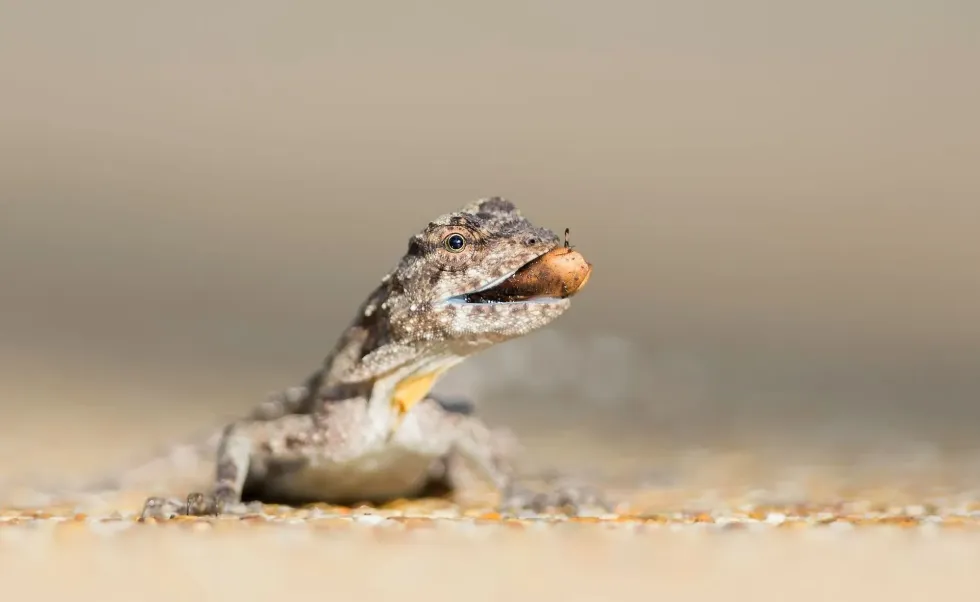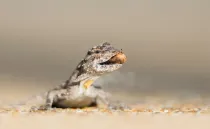The gliding lizard, known as the flying dragon or Draco lizard, is also referred to as the common flying dragon for its astonishing flying and gliding capabilities. They use their modified ribcage to glide in mid-air. This species is primarily found in Southeast Asia and Southern India.
Their genus name Draco volans, also commonly called Draco lizard, is derived from the Latin term for mythological dragons for their exceptionally unique wing-like ribs and their wings. In 1758, Carl Linnaeus, described the genus, with the type species being Draco volans.
Researchers and scientists refer to this modified membrane as 'patagium', which enables this species to glide or fly in mid-air, from tree to tree.
A patagia is also commonly found on flying squirrels, flying frogs, and bats. Though bats have actual genetically modified wings, their wings gain height using a membrane, unlike other animals capable of flight, who use feathers to gain height.
In the early and mid 20th century, there were controversies about the gliding capabilities of a common flying dragon, with some researchers suggesting that the patagia of common flying dragons were solely for display, but the latest studies and research in the late '50s firmly established the gliding or flying functions of the patagia.
The Draco volan's ability to glide makes them different from regular lizards or any other reptiles. Their species come in different colors, patterns, and dark skin with very impressive camouflage.
If you find facts about rare animals interesting, consider checking out collared lizard and regal horned lizard facts.
Gliding Lizard Interesting Facts
What type of animal is a gliding lizard?
The common flying lizard or flying dragon is a reptilian lizard with the ability to fly or glide and has a dragon-like appearance, hence the name Draco volans.
What class of animal does a gliding lizard belong to?
It belongs to the class of reptiles but unlike other reptiles or lizards, it has exceptional abilities of camouflage and flight.
How many gliding lizards are there in the world?
42 different species of common flying lizards or flying dragons have been recognized by researchers and scientists all over the world. The exact population density is unfortunately unknown.
Where does a gliding lizard live?
All the members of Draco are primarily arboreal and live in tropical rainforests. A flying dragon or flying lizard is rarely found on the forest floors.
The common flying dragon is typically found in tropical or dry open secondary forests and rainforest areas. They need a high density of trees in their environment for them to jump or glide from one tree to another tree without getting down to the ground.
Flying dragons are insectivorous and primarily feed on ants and termites. The color of the patagium is strongly correlated to the color of the local falling leaves, likely as camouflage against predatory birds.
What is a gliding lizard's habitat?
The flying lizard (Draco volans) primarily lives in trees, so, naturally, they inhabit tropical rainforests or a dense forest, where there is a huge population of trees. While they dwell at sea level, studies have found they inhabit mountainous regions too, still, tropical rainforests are their most common ecosystem.
Unfortunately, the complete habitat preferences of this species are inconclusive as researchers could still not thoroughly study it. The places one is most likely to find a flying dragon are the Philippines, India, Malaysia, Borneo, and Indonesia.
Who do gliding lizards live with?
A flying dragon (Draco volans) lives with its mates in its own territories. These territories include two to three trees. In these trees, they mate with their partners and reproduce. After the eggs hatch, the baby of a flying dragon is left independent and receives no external protection from their mothers or fathers.
How long does a gliding lizard live?
The average life expectancy of a flying dragon is nearly about twenty years. However, in the wild, there are several other elements that affect the life span of Draco volcans. Predators like large birds, snakes, and monitor lizards prey on these lizards cutting their life span short.
How do they reproduce?
Though it is not known exactly when the reproduction cycle of flying lizards occur, it is assumed to be in the month of December and January.
Males, and occasionally females, show several signatures which include the spreading of the wings and a bouncing motion of their entire body when the two are in close vicinity to each other.
The male lizard also spreads his dewlap to a fully erect position and continues circling the female three times before copulation. The female-only shows display patterns to stop copulation or to prevent copulation.
Female Draco volans build their nests for the eggs by forcing her head into the soil to create a small hole. After that, she lays her eggs (approximately two to five) into that hole and covers them with dust, and finally packs the soil on top of them by patting the soil with her head.
The female Draco will then guard the eggs fiercely for approximately twenty-four hours. The incubation process of the eggs takes approximately up to 32 days after this period, newly born flying dragons are left independent, and no further guarding occurs.
What is their conservation status?
The IUCN Red List declared the conservation status of flying dragons as Least Concerned.
According to the IUCN Red List, this species is present in several protected areas throughout its known distribution range and presently there are no in place or any species-specific conservation measures for the flying dragons.
Gliding Lizard Fun Facts
What do Gliding Lizards look like?
The key characteristic feature of the gliding lizard (Draco volans) is their modified membranes, Patagia, along the sides of the body, which provides them with the ability to fly. These are supported by their elongated and uniquely modified ribs.
Their body is very soft and elongated. The male lizard is approximately about 7.4 in (19 cm) long while the female is 8.2 in (21 cm) long. This includes the length of their long and slender tail goes for approximately 4.3 in (11 cm) for male lizards and 5.1 in (13 cm) for females.
They also have a gular flap called a dewlap under their head. This tissue is used primarily during displays. Male flying dragons have a long pointed bright yellow dewlap.
They also have bluish color under their wings and brown on the upper side. Females are a little different, their dewlap is smaller and bluish-grey. Also, the lower of the wings is yellow.
The species is distinguished from other Dracos by the rows of rectangular brown spots on the top of their wing membranes, and black spots on the bottom of their wing membranes.

How cute are they?
They are elegant and beautiful, their soft skin and vibrant colors make them more appealing than other animals and reptiles. But by nature, they might not be as adorable as other animals and reptiles, despite having a certain charm in themselves.
How do they communicate?
Much like other lizards, this species also communicate through their actions and chattering noise. Males use their dewlap to attract females within their proximity by spreading their dewlap to a fully erect position. They usually stay among their territories in the trees and avoids the ground.
How big is a gliding lizard?
The approximate size of a male lizard is about 7.6 in (19.3 cm) long while the female is approximately about 8.3 in (21 cm) long. This includes the length of their long tail that goes for approximately 4.4 in (11.1 cm) for male lizards and 5.1 in (12.9 cm) for females.
If we compare them to sand lizards, which are about 8 in (20.3 cm) long, and lava lizards which are 6-12 in (15-30 cm) in length, they will appear similar in size.
How fast can a gliding lizard move?
When it comes to the movement they are pretty quick.
These lizards use their wing membranes to glide or fly between trees. Being able to glide helps them to avoid going to the ground which enables them to avoid many predators. A single glide can carry them up to 8 m (26 ft).
How much does a gliding lizard weigh?
The average weight of this species varies between 0.64 oz (18.1 g).
What are the male and female names of the species?
Unlike other reptiles or an animal, these lizards don't have different names to be referred to based on their sex.
These lizards, like many other animals, are sexually also dimorphic, they not only have different genitals, but other characteristics such as size, shape, and appearance are different too.
What would you call a baby gliding lizard?
Unfortunately, the newborn lizards, too, have no different name to be referred to. In research papers, they are mentioned simply as baby gliding lizards.
What do they eat?
Flying lizards are insectivores by nature. Their diet consists of insects like ants and termites.
This species is known for its extreme patience while preying, it quietly sits next to the tree trunk and waits for its prey to come to it. When they get close enough, the lizard effortlessly picks up the insect without even moving a muscle. It then chews the insect.
Are they poisonous?
Though in some cultures, people believe that these lizards are venomous, it is most certainly not true. Their wild nature and unique appearance made this a popular belief but researchers have evidence that proves otherwise.
Would they make a good pet?
Flying dragons are secretive and are not ideal as a pet, especially for someone who likes to handle their reptile often. In some parts of the world having a flying lizard as a pet is banned and illegal.
Though not venomous, a wild animal such as Draco volans is always better left in a tree where it belongs.
Did you know...
Draco lizards are highly territorial, their home territory range consists of two to three trees. These trees are actively protected by males, as territory-less males search the forest landscape in search of empty areas. Experiments and studies have determined that suitable and unoccupied territories were claimed within a few hours of the removal of a dominant male.
Adults of this species are extremely fragile which makes them very difficult to capture.
Studies have also shown that these species are diurnal, or active during the day.
Why are they called gliding lizards?
The wing-like membrane in their body grants them the ability to fly among trees and avoid the ground as much as possible. Though their colorful skin helps grants them camouflage to escape the sight of predators, flying or gliding from one tree to another makes predators more avoidable.
Their modified ribs help this process while they use their long tails to steer themselves.
This distinguishes them from other uncommon reptiles like Texas horned lizards and frilled lizards in the world, and are hence called gliding lizards.
Are flying lizards dangerous?
No, contrary to popular belief they are not venomous and do not pose any threat or danger to anyone.
Here at Kidadl, we have carefully created lots of interesting family-friendly animal facts for everyone to discover! For more relatable content, check out these caiman lizard facts and sagebrush lizard facts for kids.
You can even occupy yourself at home by coloring in one of our free printable lizard coloring pages.
Image two by Deepugn.









